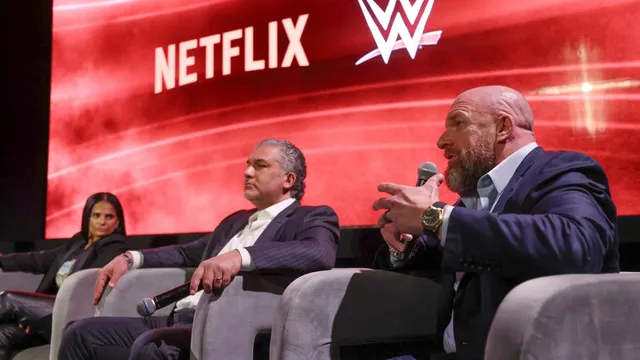
WWE's Raw begins a controversial 10-year streaming deal with Netflix
2025-01-05 03:47- WWE's 'Raw' officially premieres on Netflix as part of a new 10-year partnership.
- The deal is valued at over $5 billion and includes streaming rights for additional WWE shows.
- This transition reflects a significant change in media consumption away from cable TV to streaming platforms.
Express your sentiment!
Insights
In a notable shift within the entertainment and wrestling industries, WWE signed a landmark deal with Netflix to move its flagship program 'Raw' to the streaming platform. The 1,650th episode aired from the Intuit Dome near Los Angeles, marking the beginning of this new partnership. This switch ends a long-standing relationship WWE had with cable television, reflecting broader trends in media consumption as audiences increasingly turn to streaming platforms for content. The deal, estimated to surpass $5 billion, not only grants Netflix exclusive streaming rights for 'Raw' but also extends to other WWE programming including 'Smackdown', 'NXT', and major live events like WrestleMania and SummerSlam. The streaming giant boasts an extensive international reach, with 282.3 million subscribers across more than 190 countries, making the partnership mutually beneficial. Béla Bajaria, Netflix's chief content officer, emphasized the blend of great storytelling, character development, and the unique WWE fan culture as key factors in pursuing this partnership. Brandon Riegg, vice president of nonfiction series and sports at Netflix, highlighted the value of WWE's stable audience and the social media engagement surrounding the events, which made this collaboration a strategic fit for the platform's future programming schedule. Previously, ‘Smackdown’ made its transition to USA Network while ‘NXT’ shifted to CW three months ahead of the 'Raw' premiere on Netflix. This transition happens in a media environment where traditional television viewership has declined, and streaming has gained popularity. Given the massive success of WWE’s live events overseas, combined with its thrilling blend of action and drama, Netflix aims to leverage this fanbase and further monetize WWE content globally. The debut episode of 'Raw' on Netflix aimed to deliver a premium experience, especially with the farewell tour of WWE superstar John Cena, who is scheduled for three main event matches before retiring at year-end. There is also speculation about possible appearances by legendary figures like Dwayne 'The Rock' Johnson, hinting at exciting moments for the audience anticipated to tune in. This partnership signifies a monumental change not just in how wrestling content is consumed, but also illustrates the ongoing evolution of entertainment in response to changing viewer habits.
Contexts
The rise of streaming services has significantly impacted the landscape of cable television, prompting a fundamental shift in how consumers access and enjoy content. As of early 2025, streaming platforms such as Netflix, Hulu, Amazon Prime Video, and Disney+ have garnered millions of subscribers, offering an extensive array of on-demand content that often surpasses the offerings of traditional cable providers. The convenience and flexibility of streaming, allowing users to watch content anytime and anywhere, have contributed to a notable decline in cable subscriptions. Many viewers, particularly younger demographics, now prefer streaming services that cater to their viewing habits, enabling them to skip advertisements and binge-watch entire seasons at their leisure. This trend has redefined viewer expectations, making cable television feel increasingly restrictive and outdated in comparison to the more dynamic streaming options available today. Alongside the decline in traditional cable subscribers, there has been a marked increase in the quality of original programming produced by streaming services. With substantial investments in exclusive content, these platforms have raised the bar for storytelling and production values, further drawing audiences away from cable networks. In turn, cable companies have had to adapt by developing their own streaming platforms to retain viewers, often bundling services to offer some combination of live TV, on-demand content, and exclusive programming. This competition has not only fueled innovation in content delivery but has also forced traditional cable outlets to rethink their pricing strategies and service offerings, often resulting in a fragmented media environment where viewers can choose from multiple subscription-based services. The shift from cable to streaming has also brought about changes in advertising practices. With the decline of traditional cable, advertisers have had to adjust their strategies to reach audiences through digital platforms, where they can leverage data and analytics to deliver targeted ads. This evolution has led to an increase in ad-supported streaming options, where consumers can access content for free or at a reduced cost in exchange for watching advertisements. As a result, advertisers are finding new ways to connect with consumers, moving away from the one-size-fits-all approach of cable advertising. This has created a more tailored viewing experience, but it also raises questions about user privacy and data security as streaming platforms track viewer preferences to enhance their ad offerings. In summary, the impact of streaming on cable television has been profound, reshaping consumer behavior, altering programming quality, and changing advertising dynamics. As streaming services continue to evolve and innovate, the future of cable television remains uncertain. While cable may not disappear entirely, its traditional business model faces significant challenges as more viewers opt for flexible, on-demand streaming experiences. The industry must respond to these shifts by embracing technology and adapting to the new expectations of consumers, striving to create value in a rapidly changing media landscape.